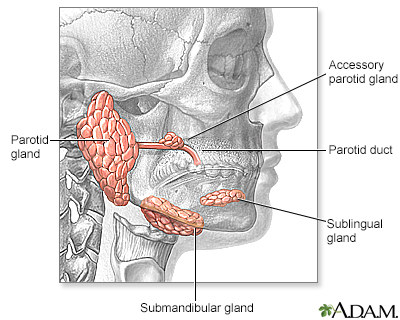Pregnancy SmartSiteTM
Epidemic parotitis; Viral parotitis; Parotitis DefinitionMumps is a contagious disease that leads to painful swelling of the salivary glands. The salivary glands produce saliva, a liquid that moistens food and helps you chew and swallow. CausesMumps is caused by a virus. The virus spreads from person to person by drops of moisture from the nose and mouth, such as through sneezing. It is also spread through direct contact with items that have infected saliva on them. Mumps most often occurs in children ages 2 through 12 who have not been vaccinated against the disease. However, the infection can occur at any age and may also be seen in college age students. The time between being exposed to the virus and getting sick (incubation period) is about 12 to 25 days. Mumps may also infect the:
SymptomsSymptoms of mumps may include:
Other symptoms that can occur in males are: Exams and TestsYour health care provider will perform an exam and ask about your symptoms, especially when they started. No tests are needed in most cases. Your provider can usually diagnose mumps by looking at your symptoms. Blood tests may be needed to confirm the diagnosis. TreatmentThere is no specific treatment for mumps. The following things can be done to relieve symptoms:
Outlook (Prognosis)People with this disease do well most of the time, even if organs other than the salivary glands are involved. After the illness is over (usually in about 7 days), they'll acquire immunity to mumps for the rest of their life. Possible ComplicationsInfection of other organs may occur, including testicle swelling (orchitis). When to Contact a Medical ProfessionalContact your provider if you or your child has mumps along with:
Call 911 or the local emergency number or visit the emergency room if seizures occur. PreventionMMR immunization (vaccine) protects against measles, mumps, and rubella. It should be given to children at these ages:
Adults can also receive the vaccine. Talk to your provider about this. Recent outbreaks of the mumps have supported the importance of having all children vaccinated. ReferencesGans HA. Mumps. In: Kliegman RM, St. Geme JW, Blum NJ, et al, eds. Nelson Textbook of Pediatrics. 22nd ed. Philadelphia, PA: Elsevier; 2025:chap 295. Litman N, Baum SG. Mumps virus. In: Bennett JE, Dolin R, Blaser MJ, eds. Mandell, Douglas, and Bennett's Principles and Practice of Infectious Diseases. 9th ed. Philadelphia, PA: Elsevier; 2020:chap 157. Rosen JB, Zucker JR. Mumps. In: Goldman L, Cooney KA, eds. Goldman-Cecil Medicine. 27th ed. Philadelphia, PA: Elsevier; 2024:chap 340. | |
| |
Review Date: 4/17/2024 Reviewed By: Neil K. Kaneshiro, MD, MHA, Clinical Professor of Pediatrics, University of Washington School of Medicine, Seattle, WA. Also reviewed by David C. Dugdale, MD, Medical Director, Brenda Conaway, Editorial Director, and the A.D.A.M. Editorial team. The information provided herein should not be used during any medical emergency or for the diagnosis or treatment of any medical condition. A licensed medical professional should be consulted for diagnosis and treatment of any and all medical conditions. Links to other sites are provided for information only -- they do not constitute endorsements of those other sites. No warranty of any kind, either expressed or implied, is made as to the accuracy, reliability, timeliness, or correctness of any translations made by a third-party service of the information provided herein into any other language. © 1997- A.D.A.M., a business unit of Ebix, Inc. Any duplication or distribution of the information contained herein is strictly prohibited. | |

 Mumps
Mumps Head and neck glan...
Head and neck glan...
